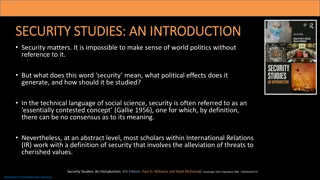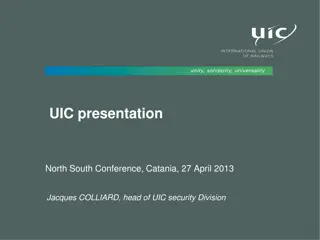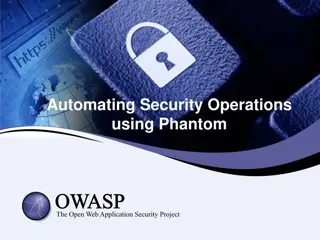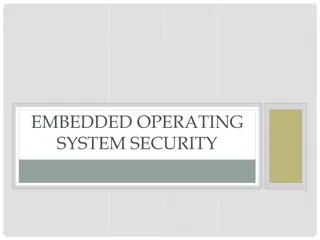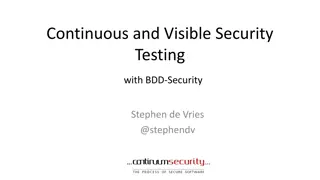
Wireless Sensor Networks and IoT Integration Challenges
Explore the challenges of integrating Wireless Sensor Networks with the Internet of Things, focusing on security, global perspective, data privacy, and component security. Learn about different integration approaches and the importance of secure interactions in IoT ecosystems.
Download Presentation

Please find below an Image/Link to download the presentation.
The content on the website is provided AS IS for your information and personal use only. It may not be sold, licensed, or shared on other websites without obtaining consent from the author. If you encounter any issues during the download, it is possible that the publisher has removed the file from their server.
You are allowed to download the files provided on this website for personal or commercial use, subject to the condition that they are used lawfully. All files are the property of their respective owners.
The content on the website is provided AS IS for your information and personal use only. It may not be sold, licensed, or shared on other websites without obtaining consent from the author.
E N D
Presentation Transcript
Wireless Sensor Networks and the Internet of Things: Do We Need a Complete Integration? Cristina Alcaraz, Pablo Najera, Javier Lopez, Rodrigo Roman Presented by Alexander Witt and Aniket Shah 1
Overview Introduction Security Integration Challenges Integration Approaches Demystifying the TCP/IP solution issues Case Study Technical Overview Conclusion Critical Review 2
Introduction WSN an important element in IoT paradigm; facilitates collaboration of heterogeneous information systems and services Many companies have bought into the above idea, working to find solutions. E.g. : A Smarter Planet by IBM, CeNSE by HP Labs Integration with the Web; 6LoWPAN uses IPv6 for web services such as SOAP and REST Many challenges associated with this sector such as security, physical and virtual connections; especially between WSN and the Internet, etc. 3
Security Integration Challenges WSN in IoT raises security challenges; paper focuses on connections at network level Security needs to be considered at a global perspective, not just local Ensures the curbing of additional requirements to integrate local nodes on a global scale Security is an important factor as it helps user perceive control over information and not vice versa Data privacy is another important feature Segregation of shared and private data Confidentiality in business scenarios 4
Security Integration Challenges Another significant aspect under consideration is Component security Security protocols at network level Interaction between objects and services Objects and infrastructures of an IoT network should be able to handle several identification and security mechanisms in a transparent and scalable way Need to reach equilibrium point in secure interactions is an interesting problem 5
Integration Approaches For network design, it is necessary to know the integration approaches to connect to both infrastructures of WSN and the Internet Classification: Stack based or Topology based Stack based: integration level depends on similarities between network stacks of WSN and Internet Classification: Front End, Gateway or TCP/IP Topology based: integration level depends on actual location of nodes Classification: Hybrid or Access Point 6
Integration Approaches [Fig. 1] 7
Stack-based Classification Front-end solution: WSN independent from the Internet Implements its own protocols All interaction managed by a centralized base station Gateway solution: WSN can exchange information with Internet hosts Internet hosts and sensor nodes can address each other indirectly through a gateway Base station acts as application layer gateway; translating lower layer protocols and routing information TCP/IP solution: WSN shares a compatible network layer protocol Sensor nodes implement TCP/IP (or 6LoWPAN) to become a part of the Internet Sensor nodes may not be able to use specific WSN protocols 8
Topology-based Classification Hybrid solution: Dual sensor nodes located at root of the WSN A set of nodes located at the edge can access the Internet directly and become base stations This approach provides redundancy and network intelligence Access Point solution: Backbone of devices that allow sensing nodes to access the Internet in a single hop WSNs become unbalanced tree with multiple roots (sensor nodes with Internet enabled nodes) Increases capabilities of nodes in the backbone network In most cases, Topology based networks are combined with Stack based classification except for the TCP/IP solution 9
Demystifying the TCP/IP solution issues TCP/IP provides best solution to integrate WSN and the Internet External system can access node information directly Nodes can query Internet for services Multiple factors to be considered for complete integration Existing issues may affect WSN whose nodes are completely integrated into the Internet More challenging to assure security of WSNs that make use of the TCP/IP solution 10
Factors determining integration approach Resilience: Security mechanisms to increase robustness against attacks (such as Denial of Service) User Authentication and Authorization: Permission storage; consider implementing single sign-on systems Communication Security: Analyze other secure communication channels (e.g. TLS); study different key exchange mechanisms Accountability: Be able to record interactions with user; will help recreate security incidents and abnormal situations 11
Factors determining integration approach Functionality: Some nodes need not be aware of the Internet due to limited functions (tasks) Hardware: Certain nodes may not connect to the Internet directly due to memory constraints of security mechanisms Inherent weakness: Decide whether certain applications should isolate nodes from the Internet; filtering traffic at the network edge Network redundancy: Necessary to develop mechanisms in TCP/IP environments to deal with exceptions such as unreachable nodes Protocol optimization: Most protocols allow a network to self-heal and optimize internal behavior; yet to be found for 6LoWPAN networks 12
Case Study SCADA Systems and First Responders Pure TCP/IP integration solution has certain limitations, especially in terms of security Application requirements determine the type of integration solution Two sensor network applications analyzed: WSN enabled SCADA system First Responder system 13
SCADA Systems SCADA Supervisory Control and Data Acquisition system Uses new technology to monitor many critical infrastructures in real time Main elements of a SCADA system: Central control systems remote monitoring of infrastructures by humans Remote subsystems located within the infrastructure; provides data/ information from various elements of the infrastructures 14
SCADA Network Architecture [Fig. 2] 15
SCADA Systems Migration to IP for automation has increased with TCP/IP real time monitoring and communication Led to development of hybrid technologies (e.g. Bluetooth, Wi-Fi, Zig-Bee, WSNs, etc.) WSNs considered as key technology Smart and autonomous Auto-configuration Self monitoring and self-healing Anomaly detection and tracking 16
SCADA Systems Industrial applications have led to various products MeshNetics nodes (Zig-Bee) launched SensiLink Integration platform Cooper Power Systems wireless Outage advisor for Electric power systems Sensus FlexNet SmartPoints for power systems Interoperability of products is based on industrial standards such as ZigBee, WirelessHART and ISA100.11a (based on the IEEE 802.15.4-2006 standard) which specifies the PHY and MAC layers of WPANs Main goal of these standards secure connectivity energy saving using a wireless mesh network interoperability with other systems data reliability 17
First Responder Systems Sensor networks play disaster response roles such as monitoring, tracking, triage etc. Hence the name first responder systems Creates and maintains information structure when other communication and support system not available Reason: Dynamic and autonomous nature of WSN Many advantages of WSN-base first responder system integration with the Internet Network at disaster location helps visualize distant evets Global view of disaster situation Interaction with centralized situation to optimize task distribution 18
Analysis [Table 1] 19
Analysis For SCADA systems, benefits of pure TCP/IP solution don t warrant complete integration of WSN with the Internet Increase in network traffic can become problematic for WSN nodes due to their limited capabilities Existence of a central entry point makes the Gateway solution vulnerable against availability attacks. This can be solved by using the Hybrid and Access Point solutions TCP/IP solution for First responders works well as there is limited overhead on nodes Benefits associated with Front-end and Gateway solutions for First responder systems are not so important in these emergency scenarios 20
Technical Overview Different technologies used to protect a WSN Cryptographic primitives (ECRYPT Stream Ciphers, PKC ECC, Rabbit) Attestation and detection systems Key management systems Security technologies being developed Secure routing Time synchronization Trust management Secure middleware Essential for protection to nodes (in nodes or inside routers / base stations) 21
Conclusion Full integration at the network level may not be necessary Some applications should not connect their nodes directly to the Internet There are more security issues when integrating WSN with the IoT: Integration of security mechanisms & services User acceptance Management of data privacy 22
Critical Review Good indication of tradeoffs existing in different approaches to integration Do not impose a doctrine for good IoT security but discuss security attributes Discuss attributes of the environment that may influence scheme selection The paper is organized well but could explain certain sections better Discuss TCP/IP connectivity to the Internet Do not mention if battery life is a constraint to consider (are WSNs wired or not) Good bearing on the value of cryptographic primitives in IoT Lightweight Simon & Speck block cipher undergoing standardization 23
Thank You 24











